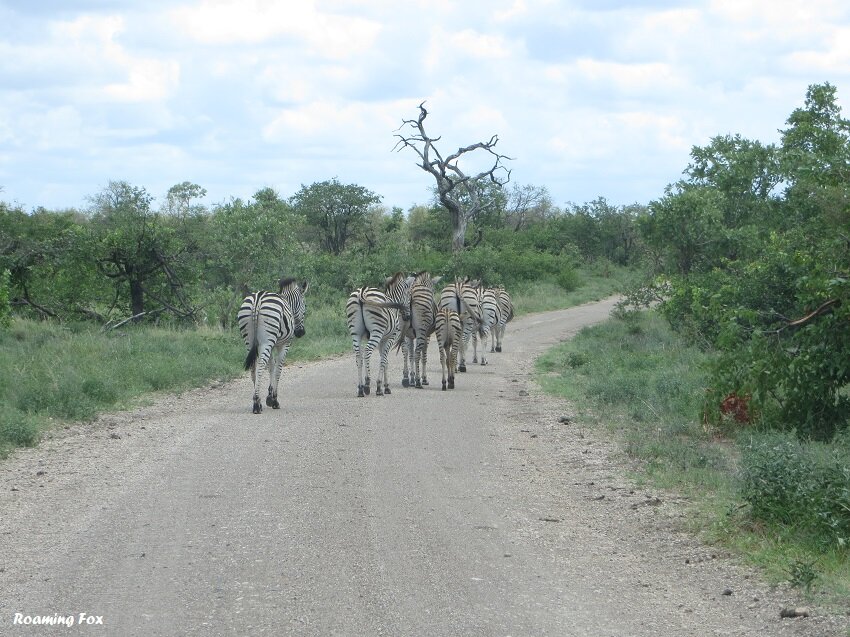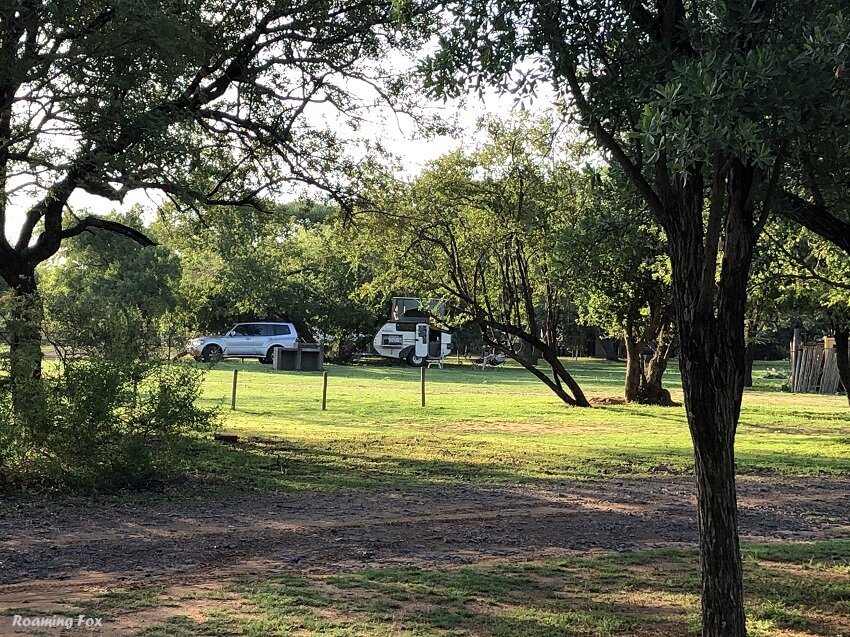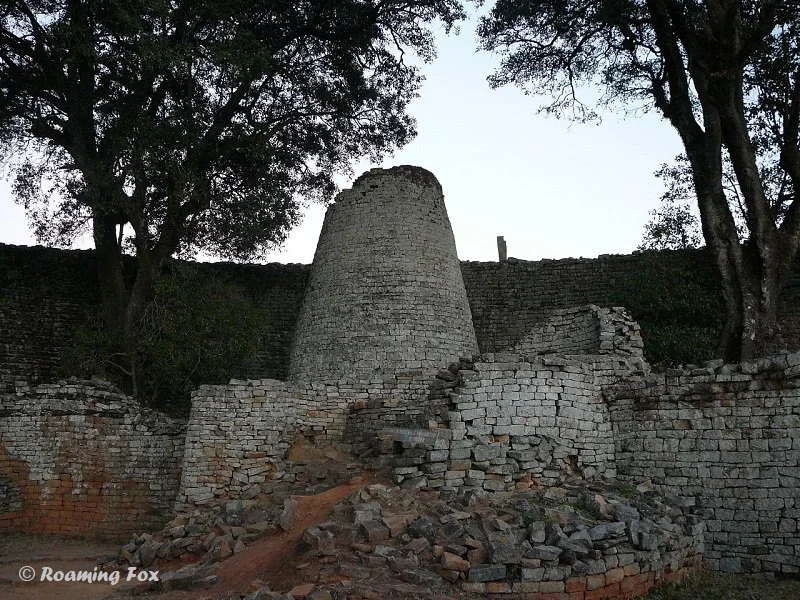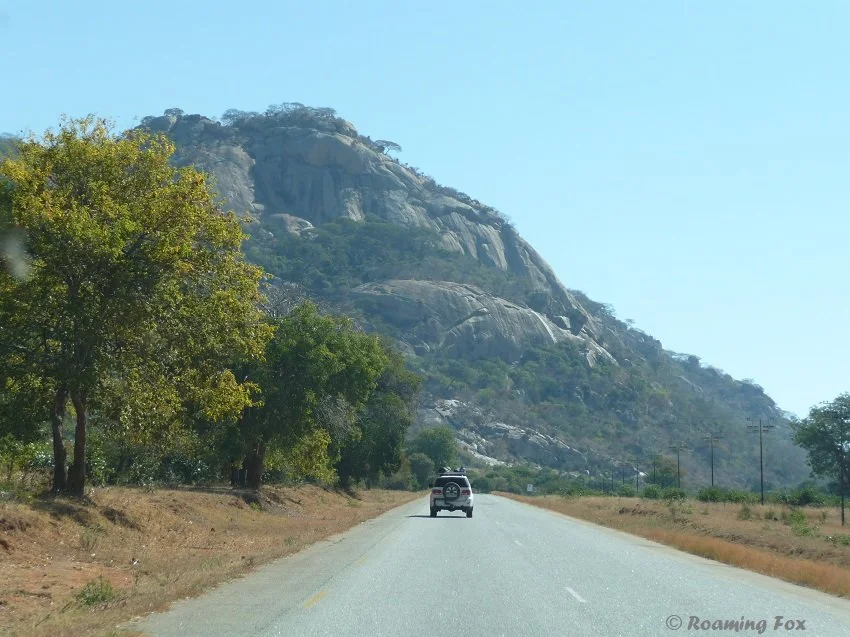Limpopo road trip route plus itinerary and Kruger National Park safari
Limpopo - Mpumalanga - South Africa
Road outside Nthakeni
Self drive road trip and safari with a caravan
It was January – the summer school holidays were almost over and we were heading off on a road trip. The joys of being semi-retired! It would be a quieter time to travel with the main rush of holidays ending at the beginning of our journey.
Part of our trip was planned with friends for a safari in the Kruger National Park for a week. The rest was unplanned. We decided to work out a rough itinerary for ourselves to travel through parts of the Limpopo. We would also be towing our caravan so would be looking for campsites and not accommodation.
Our initial route would take us on the N1 north past Mokopane, Polokwane and Tzaneen to Phalaborwa. We would meet our friends at Phalaborwa Safari Park, which is a Forever Resort, where we would spend our first night. Thereafter we would enter the park and stay at a few campsites for 6 nights.
We were concerned about the approaching end of holiday traffic heading south on the Saturday while we were travelling north and east. As per suggestion from my brother who is a regular visitor to the Kruger National Park, he recommended we leave a couple of days earlier and enter the park in the south, work our way up to Phalaborwa gate, exit the park to meet our friends and re-enter.
We could be flexible and add a few extra days on our trip. The journey would be an hour and about 100 kilometres shorter and the road should be easier to travel. We felt that was a great idea.
Therefore we traded traffic jams for animal roadblocks and negotiating crossing crocodile infested waters in the park. Only kidding, there are bridges across the rivers, so we didn’t have to drive over a float of crocodiles.
Our route and itinerary through the Kruger National Park and Limpopo:
Johannesburg via Mbombela (also known as Nelspruit) to Malelane Gate, to enter Kruger National Park.
Overnight at Berg en Dal Rest camp.
Travel north via Skukuza to Satara Rest Camp and overnight.
Satara Rest Camp to Phalaborwa Safari Park to meet friends and for overnight stop.
Phalaborwa Safari Park to Letaba for two nights.
Letaba to Shingwedzi for two nights.
Shingwedzi to Punda Maria for two nights. (This ended up as four nights at Shingwedzi and two nights at Punda Maria)
Say farewell to friends and continue north to exit at Parfuri gate.
Outside the Kruger National Park:
(we would decide length of stay at each campsite depending on our time limit. We did not book in advance, but we researched or enquired whether there was place available.)
Parfuri Gate to Nthakeni Bush & River Camp
Nthakeni Bush & River Camp to Tshipise Forever Resort
Tshipise via Mussina to Ratho Bush Camps
Ratho to Mapungubwe National Park
Mapungubwe to Marakele National Park
Marakele to Johannesburg
There is an elephant, I promise!
Our route from Johannesburg, through Kruger National Park and exiting at Parfuri Gate
Kruger National Park
Thursday morning’s weather prediction was rain most of the way from Johannesburg to the Kruger. Fortunately for us it was still dry when we packed our caravan and hitched it onto the car. On the N4 to Nelspruit Milly’s at Machado is a great stop for a comfort break and pitstop. Although we didn’t refuel or eat there, it is a well-known establishment and a popular stopover with accommodation, a restaurant and a farm stall with a petrol station.
Technically this part of our journey was through Mpumalanga but was the only part of our road trip through this province.
We drove via Schoemanskloof valley as it is a scenic mountainous route. The N4 splits northeast of Machadodorp where you can take a left turn into the R539. About 60 km further it meets up with the N4 again and continues to Nelspruit.
We could appreciate some of the beautiful scenery, but it was raining so we didn’t stop to enjoy any views.
Nelspruit is the capital city of Mpumalanga Province also known as Mbombela. We bypassed it and continued to Malelane where we refuelled our vehicle before entering the Malelane gate of the Kruger National Park.
Hot tip:
Wild card membership
Before leaving home we renewed the membership of our Wild card over the internet which is valid from date of purchase for 365 days. The Wild card is only for South African citizens or residents of South Africa. It is also possible to renew your membership at the gates where you enter the park or alternatively pay a daily conservation fee. Foreigners can purchase an International Wild Card. If you are from a SADC country the local membership applies.
Our Wild card membership fee for the year payed for itself in this trip alone as we stayed at 3 national parks where we a conservation fee or Wild card was required.
Very curious terrapins that swam towards us when we stopped
Entering the park one could feel the tension of the drive leave our shoulders. We slowed down from a just below national road speed limit of around 100 km per hour (because we were towing) to between 30-40 km an hour. Maximum speed limit in the park on a tar road is 50 km per hour and gravel is 40 km per hour.
We were now officially on safari and on route to our first rest camp! Along the way we saw a few impala and zebra as well as an elephant right next to the road. He was quite calm until he saw our vehicle as well as caravan was a whole lot bigger than him. He flapped his ears, gave a little shake as if to charge us with a low trumpeting growl to show us he meant business but didn’t charge us. We gently drove away before we annoyed him further.
Hot Tip:
Give elephants (and indeed other animals) their space. They are usually placid animals but can become quite grumpy if they feel threatened by you. There have been many incidents in the Kruger National Park where vehicles have been destroyed by elephants. You are in their territory.
On that note, I have covered our time and experiences at the various rest camps in the Kruger in depth in 10 Day Safari in Kruger National Park from South to North. We were in our caravan, so did not use any of the chalets or bungalows. We were self-catering so did not frequent any of the restaurants.
From the moment we arrived at the first campsite to the last campsite we were accompanied by the shrill but melodious cry of the Woodlands Kingfisher. This was our ‘trademark’ of the trip.
Our experience as a whole at the various campsites were pleasant. Apart from the first night at Berg en Dal, which was still part of the school holidays, the rest camps were fairly quiet.
The roads were overall in a good condition. Some roads however were closed, probably due to upgrading or maintenance.
Sculpture Olifants Rest Camp, Kruger National Park
Olifants River
The next day we travelled to Skukuza and then on to Satara Rest camp for our next overnight stop. On the Saturday we took a slight detour via Olifants Rest camp for a brief look at the river. It has one of the best views in the Kruger. Thereafter drove to Phalaborwa gate to meet our friends at Phalaborwa Safari Park.
Phalaborwa Gate, Kruger National Park
Phalaborwa Safari Park
Meeting our friends at Phalaborwa Safari Park and a short overnight stop, we found the campgrounds just outside the Phalaborwa gate pleasant. The ablution facilities were clean. This Forever resort is almost opposite the Bushveld Terrace Hotel & Guest House where we had our dinner – the only meal we wouldn’t prepare. The food was lovely and tasty and the staff were friendly and helpful.
Shingwedzi Rest Camp Campsite
Back to Kruger National Park
The following morning we continued to Letaba. The original plan was to stay two nights each at Letaba Rest Camp, Shingwedzi Rest Camp and Punda Maria Rest Camp. Unfortunately one of the vehicles broke down just outside Shingwedzi and managed to limp into the rest camp.
While they waited for spare parts and a mechanic to arrive from their hometown, to fix their vehicle, they needed to stay at Shingwedzi as they could not drive further. We decided to stay together as a group. We changed our booking at Punda Maria for two extra nights at Shingwedzi.
Punda Maria waterhole and hide
Flash floods
Parfuri gate, northern Kruger National Park
Thereafter the rest of the group meandered back home while we carried on north. Because we had never been to Punda Maria, we chose to still spend two nights there, before leaving the Kruger National Park via Parfuri gate.
Bateleur
Buffalo
Limpopo Province
Limpopo Province is the northernmost province of South Africa and shares its border with Botswana, Zimbabwe and Mozambique. It also shares provincial borders with Gauteng, Mpumalanga and North West provinces and of course the Kruger National Park. Limpopo is famous for its Baobab trees, its bushveld and wildlife reserves.
Baobab
We had about a week at our disposal and there were a couple of bush camps in the Limpopo that we wanted to explore. We had to consider the time we had left and wanted to allow for a stopover on the way down to Johannesburg at the end of our trip so that the home journey wouldn’t be too long.
Our route from Parfuri Gate through northern Limpopo back to Johannesburg
Nthakeni Bush & River Camp
Just 6 km outside Parfuri gate is Nthakeni Bush & River Camp. It was recommended to us by our friends. A delightful campsite with no electricity. In other words, tranquil off the grid indulgence at an off the beaten track bushcamp that of course needs its own blog.
If you are self-sufficient with solar power for your fridges, it is a great place to camp for a night or two. Hidden away in a north-eastern corner of South Africa in Limpopo, it is a spotless, quiet, rustic bush camp. It is also very secluded.
We only spent one night there, not sure if our newly acquired solar panels would cope with two batteries but we could easily have stayed for two nights. They do also have two cottages and a few safari tents.
It was just as well we were delayed by 2 days in the Kruger National Park, as we would not have been able to cross the bridge to Nthakeni. They had received 110 mm of rain a day or two before us and large trees had washed down the river against the bridge.
Nthakeni campsite
Tshipise Forever Resort
Reluctant to leave but wanting to explore Tshipise, we headed west. We’d heard this was where the grey nomads come to park off for a couple of months at a time during winter.
Being a Forever Resort we were expecting a well-established resort, which it was. A friendly welcome at a beautiful reception. A shop and restaurant on site and warm baths to soak your rheumatic bones as well as a warm swimming pool.
Tshipise
Driving into the resort, the trees are beautiful but we were disappointed with the state of the sites. Although parts looked green there were more thorns and weeds than lawn. The rocky hill behind the resort creates a beautiful backdrop.
The ablutions were lovely as well but for campers not altogether practical. The showers do have a bench and hooks to put your towels, dry clothes and toiletry bags, but to get to it you have to curl yourself around a small space or stand in the shower before you can close the door – which is fine when it is dry...
The warm baths must be lovely in winter but in the heat of summer is not that welcoming. We had a quick dip but couldn’t stay in for long. There is a cold-water swimming pool as well but the day we arrived it was rather green. I will admit though, the following morning when we drove out it was sparkling blue.
Although pleasant, I’m not sure if Tshipise would see me again. Maybe it wasn’t a fair test. A section of the resort looks somewhat like a storage space, for caravans that are not in use, so not a pleasant view to look at.
Only one ablution block was open, which is understandable from a budget point of view as there was only one other caravan, a permanent or semi-permanent one.
Talking of permanent campers, the above photo looks like one of those set ups. A caravan and canvas mansion with rooms for just about every purpose, from bedrooms to living rooms, kitchen to a TV room and even a garden in front!
Later in the day G-adventures arrived with a bus load of young travellers who had to share our facilities. While we coped, it would have been wiser if they were allocated their own bathrooms as there were plenty.
After Tshipise we needed to refuel at Musina and stock up on some fresh foods. The next place for fuel would be Alldays and driving in remote areas, one must consider where there are fuel stops.
Musina is a busy town, with chaotic traffic at times and not for the faint hearted. The N1 through the town is a main access route for the northern parts of Limpopo but also to neighbouring Zimbabwe and other African countries. As a result there are often massive trucks passing through.
Musina mall is lovely though but the parking area can be equally chaotic. We parked at one end of the mall for our shopping which we did at Checkers. I used the bathrooms at the mall which were clean at the time. It took me about ten minutes to walk from the one side to the other to find the only bathrooms. At least, that is what it felt like.
Going further west in the Limpopo Province, the road from Musina to Mapungubwe and then on to Ratho is filled with potholes, so one must stay alert.
Ratho campsite
4x4 river route Ratho
River bush camp Ratho
Ratho Bush Camps & Rakwena Crocodile Farm
I will also dedicate a separate blog to Ratho. We were hoping to stay at the bush camp right next to the river, but it is closed in the summer months for certain periods in case of floods.
As it was we were fortunate to have the entire place to ourselves. We were in the side camp with an eclectic bathroom and the more we stayed the more it grew on us. The only downfall was the smell from the crocodile farm and the pumps running. We chose to spend two nights at Ratho and experienced ‘adventurous’ wildlife encounters .
Den Staat road between west and east side of Mapungubwe
Elephants on the Den Staat Road
Mapungubwe National Park
Because we were so close to Mapungube, we were very keen to spend a night at Mazhou campsite in the national park. We were however concerned that the monkeys would be a problem like they were last time. We were pleasantly surprised as they didn’t come to the campsite at all. We saw them and baboons just outside the campsite but they posed no problems.
We could have easily stayed another night or three at Mapungubwe. Maloutswa hide has reopened since the floods and is stunning for birdlife. I could have sat there for hours.
We saw many animals, on both the west and the east side – far more than our previous visit which was in autumn.
This will also be a separate blog where I will give you 15 Reasons why not to visit Mapungubwe .
We were now running out of time and needed to head back to Johannesburg. We chose to spend our last night at Marakele National park. The drive from Mapungubwe to Marakele took us forever although it was only about 400 km.
We refuelled at Alldays and asked the petrol attendant if there were any potholes between Alldays and Lephalale. He nodded and said 70 km. We weren’t sure if he meant at 70 km there were some potholes or if there were 70 kilometres of potholes. It turned out to be the latter.
It reminded us of our early travels to Mozambique, but worse. This of course slowed down our journey and was not pleasant. In certain areas all that was left of the tar or asphalt was the potholes that had been fixed previously. The rest was gravel or sand.
Once again we refuelled, this time at Lephalale.
Marakele National Park
Although we had stayed at Marakele before it was at the Tlopi Tented Camp. This would be our first stay at the Bontle Rest Camp that has 36 campsites with power and 10 permanent safari tents.
Unfortunately we couldn’t do justice to Marakele, as by the time we had arrived in the late afternoon, we had done enough driving for one day. We were also leaving the next morning and would have a few more hours on the road, therefore weren’t keen to go on a game drive in the morning either.
Marakele mountains
Bontle Rest Camp, Marakele
The last section of our route was from Marakele to Johannesburg via Brits. There are road works with a few stop and go’s and this took us a little longer but probably only added half an hour to our journey.
Punda Maria rest camp in the rain
Conclusion:
Facts or hot tips:
The 18 days we were on the road passed quickly. We could have continued our road trip and the life of Silver Nomads but we had to return to our home. We chose to do this trip with our caravan which makes it a relatively low budget road trip regarding accommodation. Our costs were fuel, campsites, conservation fees, self-catering food and drinks, apart from one meal at a restaurant.
We found our caravan quick and easy to set up, so much simpler than our old 4x4 trailer with a rooftop tent. It is comfortable enough but not luxurious.
Unless you’re just passing through an area, spend at least two nights in a place to have a chance to explore and get to know it. Even then you won’t be able to experience every part of it.
In many of the places we stopped cell coverage for Vodacom was poor or intermittent. We used our cellular phones as well as a WIFI router, all with Vodacom sim cards. Many of the smaller towns and remote or rural areas have cell phone coverage with MTN. Most of the places we were at didn’t have WIFI.
We took malaria prophylaxis, (doxycycline) usually a good idea for the Kruger National Park and also for the northern Limpopo. However, we saw very little mosquitoes, whether it was because of the drought previously or because they spray, I am not sure.
It is true that the Limpopo is known for its baobabs. I have never seen so many in my life before. If you love baobabs, this is where to go.
The heat in January can be rather oppressive and there often is a good chance of rain, but it is still a good time to go on a road trip and safari. This is the time to see baby animals. Cuteness overload! If it rains, there are some areas that may not be passable, so worth considering when planning your itinerary.
Keep it simple – don’t load more than you need.
Our caravan tyre had a puncture which was fixed by Ivan at Shingwedzi. We could have fixed it ourselves, but it was far easier paying him to do it.
The auxiliary battery in our vehicle died on the trip, which was 2 years old – relatively new in battery life. Thankfully we had the main battery in our car as well as the battery in our caravan.
Talking of silver nomads – none of us are in our youth anymore. Two of our group needed ‘physiotherapy’. One to get phlegm off his chest and the other to relieve back pain. Health can certainly be an issue when you travel to remote areas. Thankfully both were on the mend, if not fully recovered. This is a vital part of going on a trip; is it within your capabilities, health wise. Also always a good idea to have a medical aid kit and if you are on chronic or regular medication, have an emergency supply at hand.
Depending on where you’re going, I would suggest a supply of fresh food for about 5 days to a week. Camping fridges and freezers are usually quite small, so cannot hold much. Fresh supplies are not always available or if they are it is limited. I would also suggest having a supply of emergency meals such as pastas and sauces or canned foods are worth having.
Fuel is available at the main rest camps in the Kruger National Park. It is usually more expensive than your average filling station but it is convenient to be able to fill up. We used our credit card but at Shingwedzi we had an issue with payment as the signal was very poor and the card machine did not want to connect. After many attempts we eventually paid.
Shop at Shingwedzi Kruger National Park
This was a trip that we thoroughly enjoyed and would happily do again. I hope that our itinerary and route for this area will help you if you every choose to do a similar trip, whether you are towing a caravan or staying in accommodation.
A perfect end to our Limpopo and Kruger National Park safari and road trip
Related Posts:
10 Day Safari in Kruger National Park from South to North
Nthakeni Bush Camp – tranquil off the grid indulgence
Adventurous wildlife encounters at Ratho Bush Camp
15 Reasons why not to visit Mapungubwe
Quick Links:
Millys of Machado https://millys.co.za/
Wild card https://www.sanparks.org/wild_new/
Phalaborwa Safari Park https://www.phalaborwasafaripark.co.za/
Kruger National Park https://www.sanparks.org/parks/kruger/
Bushveld Terrace Hotel & Guest House https://www.bushveldterrace.co.za/
Nthakeni Bush & River Camp http://www.nthakeni.com/
Tshipise Forever Resort https://www.forevertshipise.co.za/
Ratho Bush Camps & Rakwena Crocodile Farm http://www.ratho.co.za/
Mapungubwe National Park https://www.sanparks.org/parks/mapungubwe/
Marakele National Park https://www.sanparks.org/parks/marakele/
G Adventures https://www.gadventures.com/destinations/africa/south-africa/
You might like these:
Let’s connect on Social Media:
If you have any comments, questions or suggestions, please comment below.
Step by step instructions on how to leave a comment on my blog:
Type in your comment in the comment box.
Click ‘Post Comment’
Briefly a message should appear saying you are not logged in, then a box with ‘Post a Comment’ will appear for you to complete with your name, email address and website URL (if you have one).
Fill in your first name and email address in the appropriate section. (Your email will not be made public and will not be used for any other purpose than for you to get a notification of a reply to your comment.)
Click ‘Comment as Guest’ and you’re good to go!
To subscribe to my blogs, please fill out the SUBSCRIBE form.
Thank you.
I know it is quite a process, but it helps keep our websites secure. Your email address will not be shared or displayed.



































































The Best Way to see a country? Take a road trip! Have you ever had that feeling when you hit the open road on your road trip? Freedom. Anticipation. Exhilaration.